Abstract
Healthy teens and adults performed four vagotonic maneuvers. A large series of strabismus surgery patients had deliberately quantified tension on extraocular rectus muscles during general anesthesia. The mean bradycardia was greatest for diving response (apneic facial exposure to cold) and Valsalva maneuver and least for pressure on the globe and carotid sinus massage. Bradycardia occurred for every subject for the non-surgical maneuvers, however, extraocular muscle tension frequently caused no change in heart rate or even tachycardia. The inter-subject variance in percent heart rate change was greatest for surgical oculocardiac reflex. Of the rectus muscles, the inferior caused the most bradycardia while the lateral caused the least. The percent oculocardiac reflex was not age dependent. Occasional patients demonstrated profound bradycardia with strabismus surgery. Of these maneuvers, diving response has theoretical advantage in treating paroxysmal atrial tachycardia. The human cardiac vagal efferent was stimulated by several carefully controlled maneuvers resulting in wide inter-maneuver differences in bradycardia magnitude. The greatest intra-maneuver variability occurred with surgical oculocardiac reflex.
Full text
PDF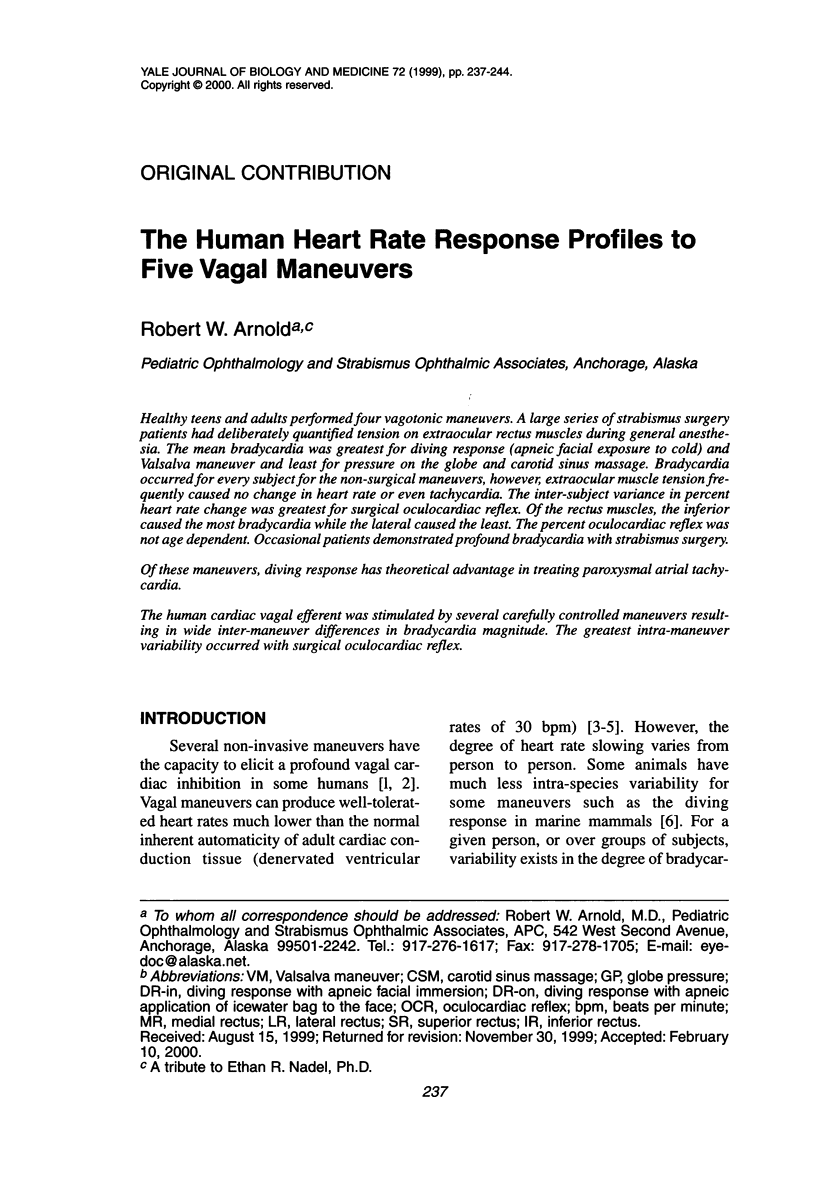
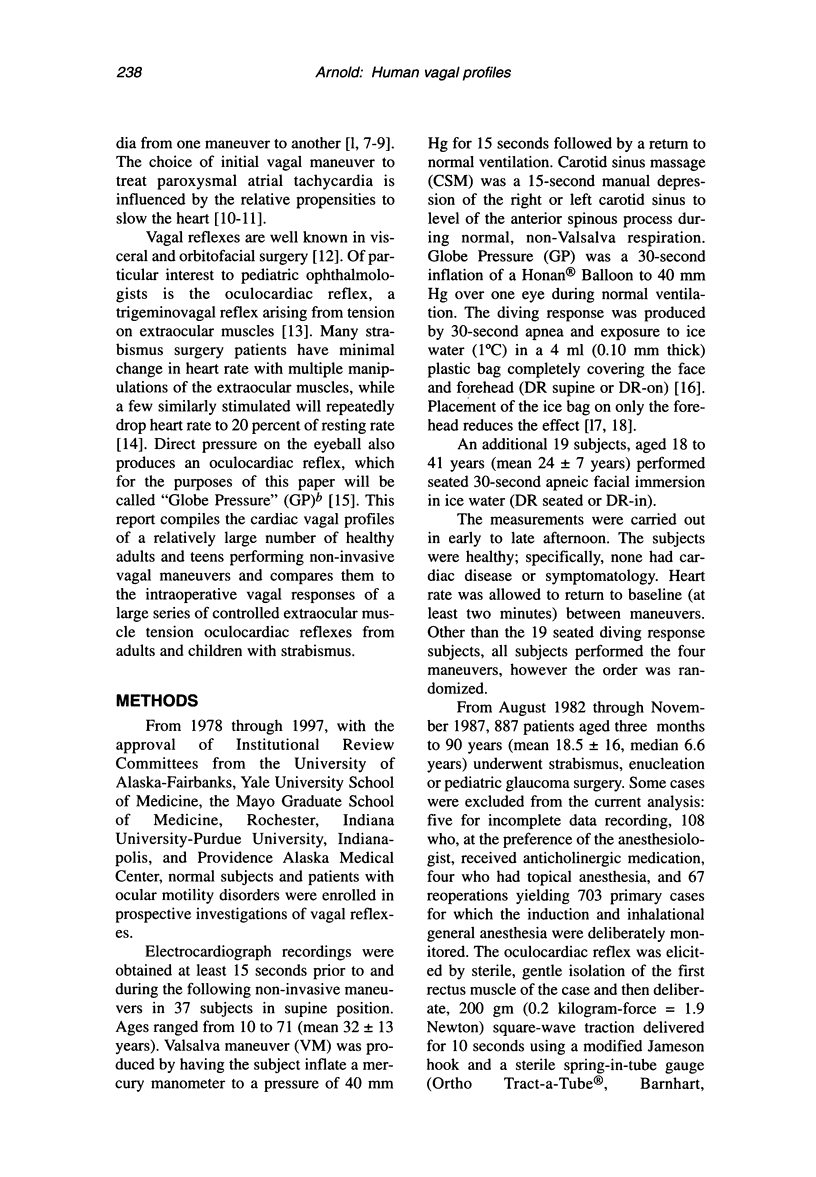
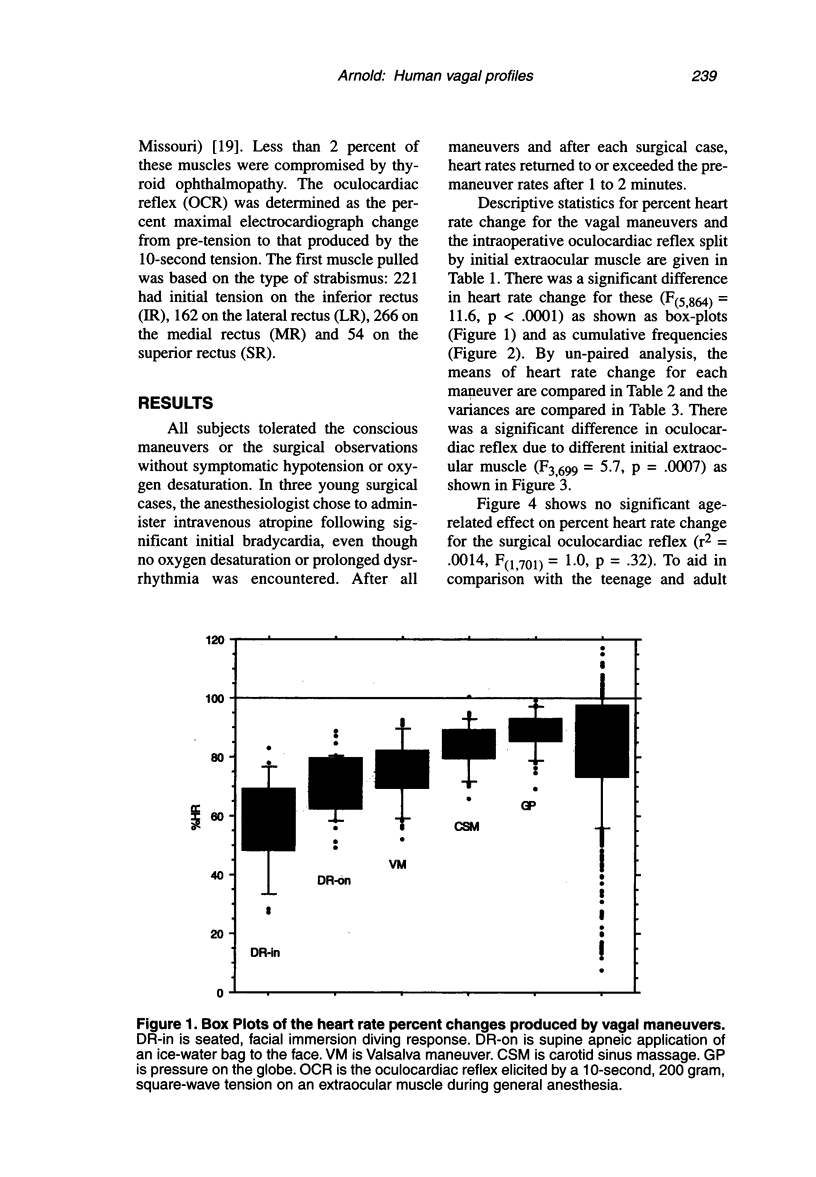
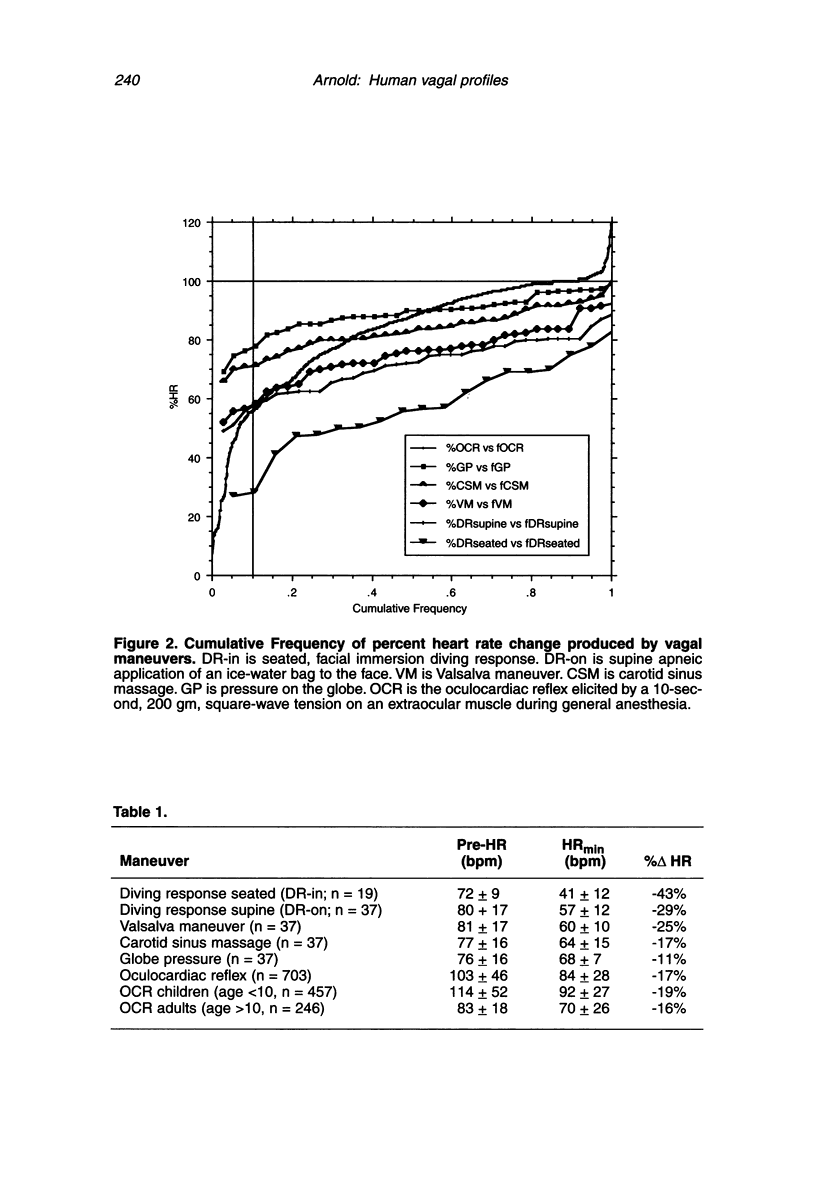


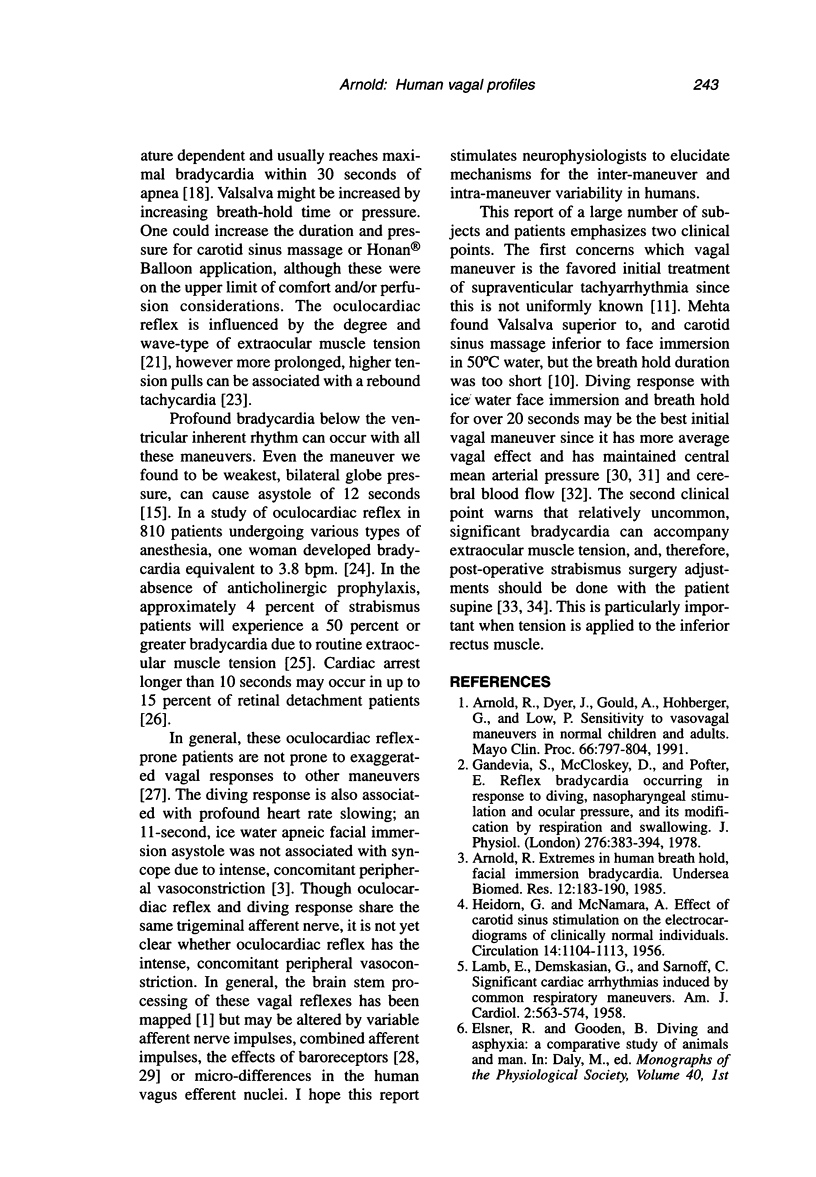

Selected References
These references are in PubMed. This may not be the complete list of references from this article.
- Arnold R. W., Dyer J. A., Gould A. B., Jr, Hohberger G. G., Low P. A. Sensitivity to vasovagal maneuvers in normal children and adults. Mayo Clin Proc. 1991 Aug;66(8):797–804. doi: 10.1016/s0025-6196(12)61197-5. [DOI] [PubMed] [Google Scholar]
- Arnold R. W. Extremes in human breath hold, facial immersion bradycardia. Undersea Biomed Res. 1985 Jun;12(2):183–190. [PubMed] [Google Scholar]
- Arnold R. W., Gould A. B., MacKenzie R., Dyer J. A., Low P. A. Lack of global vagal propensity in patients with oculocardiac reflex. Ophthalmology. 1994 Aug;101(8):1347–1352. doi: 10.1016/s0161-6420(94)31163-8. [DOI] [PubMed] [Google Scholar]
- Arnold R. W., Nadel E. R. The attenuating effect of heat and hypovolemia on the human diving response. Alaska Med. 1993 Jul-Sep;35(3):199–203. [PubMed] [Google Scholar]
- Arnold R. W., Nadel E. R. The effect of peripheral vasodilators on the human diving response. Alaska Med. 1993 Jul-Sep;35(3):204–208. [PubMed] [Google Scholar]
- Berk W. A., Shea M. J., Crevey B. J. Bradycardic responses to vagally mediated bedside maneuvers in healthy volunteers. Am J Med. 1991 Jun;90(6):725–729. [PubMed] [Google Scholar]
- Braun U., Feise J., Mühlendyck H. Is there a cholinergic and an adrenergic phase of the oculocardiac reflex during strabismus surgery? Acta Anaesthesiol Scand. 1993 May;37(4):390–395. doi: 10.1111/j.1399-6576.1993.tb03735.x. [DOI] [PubMed] [Google Scholar]
- Folgering H., Wijnheymer P., Geeraedts L. Diving bradycardia is not correlated to the oculocardiac reflex. Int J Sports Med. 1983 Aug;4(3):166–169. doi: 10.1055/s-2008-1026029. [DOI] [PubMed] [Google Scholar]
- Gandevia S. C., McCloskey D. I., Potter E. K. Reflex bradycardia occurring in response to diving, nasopharyngeal stimulation and ocular pressure, and its modification by respiration and swallowing. J Physiol. 1978 Mar;276:383–394. doi: 10.1113/jphysiol.1978.sp012241. [DOI] [PMC free article] [PubMed] [Google Scholar]
- Ganz L. I., Friedman P. L. Supraventricular tachycardia. N Engl J Med. 1995 Jan 19;332(3):162–173. doi: 10.1056/NEJM199501193320307. [DOI] [PubMed] [Google Scholar]
- Good C. B. Use of ice-water bag to obtain dive reflex. Am J Med. 1992 Jul;93(1):116–116. doi: 10.1016/0002-9343(92)90702-d. [DOI] [PubMed] [Google Scholar]
- Grover V. K., Bhardwaj N., Shobana N., Grewal S. P. Oculocardiac reflex during retinal surgery using peribulbar block and nitrous narcotic anesthesia. Ophthalmic Surg Lasers. 1998 Mar;29(3):207–212. [PubMed] [Google Scholar]
- HEIDORN G. H., MCNAMARA A. P. Effect of carotid sinus stimulation on the electrocardiograms of clinically normal individuals. Circulation. 1956 Dec;14(6):1104–1113. doi: 10.1161/01.cir.14.6.1104. [DOI] [PubMed] [Google Scholar]
- Jaeger F. J., Schneider L., Maloney J. D., Cruse R. P., Fouad-Tarazi F. M. Vasovagal syncope: diagnostic role of head-up tilt test in patients with positive ocular compression test. Pacing Clin Electrophysiol. 1990 Nov;13(11 Pt 1):1416–1423. doi: 10.1111/j.1540-8159.1990.tb04017.x. [DOI] [PubMed] [Google Scholar]
- Jiang Z. L., He J., Yamaguchi H., Tanaka H., Miyamoto H. Blood flow velocity in common carotid artery in humans during breath-holding and face immersion. Aviat Space Environ Med. 1994 Oct;65(10 Pt 1):936–943. [PubMed] [Google Scholar]
- Kawakami Y., Natelson B. H., DuBois A. R. Cardiovascular effects of face immersion and factors affecting diving reflex in man. J Appl Physiol. 1967 Dec;23(6):964–970. doi: 10.1152/jappl.1967.23.6.964. [DOI] [PubMed] [Google Scholar]
- Korner P. I., Tonkin A. M., Uther J. B. Reflex and mechanical circulatory effects of graded Valsalva maneuvers in normal man. J Appl Physiol. 1976 Mar;40(3):434–440. doi: 10.1152/jappl.1976.40.3.434. [DOI] [PubMed] [Google Scholar]
- LAMB L. E., DERMKSIAN G., SARNOFF C. A. Significant cardiac arrhythmias induced by common respiratory maneuvers. Am J Cardiol. 1958 Nov;2(5):563–571. doi: 10.1016/0002-9149(58)90182-6. [DOI] [PubMed] [Google Scholar]
- Leon D. F., Shaver J. A., Leonard J. J. Reflex heart rate control in man. Am Heart J. 1970 Dec;80(6):729–739. doi: 10.1016/0002-8703(70)90133-x. [DOI] [PubMed] [Google Scholar]
- Mathew P. K. Diving reflex. Another method of treating paroxysmal supraventricular tachycardia. Arch Intern Med. 1981 Jan;141(1):22–23. doi: 10.1001/archinte.141.1.22. [DOI] [PubMed] [Google Scholar]
- Mehta D., Wafa S., Ward D. E., Camm A. J. Relative efficacy of various physical manoeuvres in the termination of junctional tachycardia. Lancet. 1988 May 28;1(8596):1181–1185. doi: 10.1016/s0140-6736(88)92008-9. [DOI] [PubMed] [Google Scholar]
- Ohashi T., Kase M., Yokoi M. Quantitative analysis of the oculocardiac reflex by traction on human extraocular muscle. Invest Ophthalmol Vis Sci. 1986 Jul;27(7):1160–1164. [PubMed] [Google Scholar]
- Parfrey P., Sheehan J. D. Individual facial areas in the human circulatory response to immersion. Ir J Med Sci. 1975 Sep;144(9):335–342. [PubMed] [Google Scholar]
- Reed H., McCaughey T. CARDIAC SLOWING DURING STRABISMUS SURGERY. Br J Ophthalmol. 1962 Feb;46(2):112–122. doi: 10.1136/bjo.46.2.112. [DOI] [PMC free article] [PubMed] [Google Scholar]
- Robideaux V. Oculocardiac reflex caused by midface disimpaction. Anesthesiology. 1978 Dec;49(6):433–433. doi: 10.1097/00000542-197812000-00011. [DOI] [PubMed] [Google Scholar]
- Ruta U., Möllhoff T., Markodimitrakis H., Brodner G. Attenuation of the oculocardiac reflex after topically applied lignocaine during surgery for strabismus in children. Eur J Anaesthesiol. 1996 Jan;13(1):11–15. doi: 10.1097/00003643-199601000-00003. [DOI] [PubMed] [Google Scholar]
- Stump M., Arnold R. W. Iris color alone does not predict susceptibility to the oculocardiac reflex in strabismus surgery. Binocul Vis Strabismus Q. 1999;14(2):111–116. [PubMed] [Google Scholar]
- Trouerbach J., Duprez D., De Buyzere M., De Sutter J., Clement D. Cardiovascular responses elicited by different simulated diving manoeuvres. Eur J Appl Physiol Occup Physiol. 1994;68(4):341–344. doi: 10.1007/BF00571454. [DOI] [PubMed] [Google Scholar]
- Vrabec M. P., Preslan M. W., Kushner B. J. Oculocardiac reflex during manipulation of adjustable sutures after strabismus surgery. Am J Ophthalmol. 1987 Jul 15;104(1):61–63. doi: 10.1016/0002-9394(87)90294-7. [DOI] [PubMed] [Google Scholar]
- Yamashita M. Oculocardiac reflex and the anesthesiologist. Middle East J Anaesthesiol. 1986 Jun;8(5):399–415. [PubMed] [Google Scholar]


